Other Installments:
-
Imperial Brazilian Uniforms (Part 1): Line Infantry
Imperial Brazilian Uniforms (Part 3): Artillery
Imperial Brazilian Uniforms (Part 4): General Staff and Engineers
Imperial Brazilian Uniforms (Part 5): "Fixed" or Garrison Corps
Imperial Brazilian Uniforms (Part 6): Guardia Nacional
The line established by regulations of 1842 and 1852 included 4 regiments of regular cavalry. A 5th regiment was raised in 1854, for a total of 5 in existence at the outbreak of the War of the Triple Alliance. The reorganization of 1866 reduced this to 3 regiments of regular cavalry, plus 5 new "Corps" of Cacadores a Cavallo ("Mounted Rifles"), which was to remain unchanged until the end of the war.
The uniforms established by the dress regulations of 7 August, 1852, gave the cavalry dark blue uniforms similar to those of the line Fusiliers, with shako and coatee for full dress, kepi and tunic for service and undress (the so-called "Second Uniform"). Facings were to be in variations of red and dark blue, initially distinguished by white pipings, with brass buttons. The 1852 regulations quoted red collars for all in full dress, the different regiments being distinguished by variations in the cuffs and cuff flaps:
-
1st Regt.: Red cuffs with dark blue flaps
2nd Regt.: Red cuffs without flaps
3rd Regt.: Dark blue cuffs with red flaps
4th Regt.: Dark blue cuffs without flaps
On the undress tunic the red collar was reduced to a red patch on either side of the front, and cuffs were dark blue with flaps of the colour of the full dress coatee cuff. The 5th regiment, from 1854, was to be distinguished by a red collar, cuffs and piping. Shortly after this the system was slightly modified for the 1st regiment, which was to discontinue it's full dress cuff flaps, and the 2nd regiment, which was to have plain dark blue coatee cuffs edged in red piping.
The dress regulations of 1866 gave the cavalry a standardized uniform based on the undress uniform as formerly worn by the 1st regiment, with dark blue collar and cuffs, red collar patches and cuff flaps, and uniformly white piping. Details, including new uniforms and clothing items, were generally as cutlined for infantry in Part 1.
The newly-raised Cacadores a Cavallo were given a uniform almost identical to the Foot Cacadores, entirely dark blue trimmed with yellow piping, with black belts in place of the white used by the cavalry.
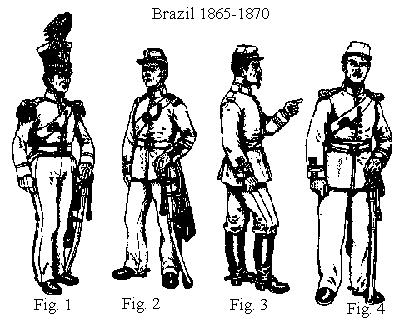 Fig. 1. Captain, 1st Cavalry Regiment, Full Dress, c.1865 Black shako with gold
plate and chinscales, gold lace top band, national cockade above the plate,
"waterfall" plume of red feathers. Dark blue coatee with red collar and cuffs,
entirely edged with white piping including the front opening, white skirt
turnbacks, gold buttons and epaulets. Dark blue trousers with a red side
stripe, crimson waistsash with gold knot and crimson tassels. White belts and
gloves, full dress sabre-knot of gold cord.
Fig. 1. Captain, 1st Cavalry Regiment, Full Dress, c.1865 Black shako with gold
plate and chinscales, gold lace top band, national cockade above the plate,
"waterfall" plume of red feathers. Dark blue coatee with red collar and cuffs,
entirely edged with white piping including the front opening, white skirt
turnbacks, gold buttons and epaulets. Dark blue trousers with a red side
stripe, crimson waistsash with gold knot and crimson tassels. White belts and
gloves, full dress sabre-knot of gold cord.
Fig. 2. Cabo de Esquadra, 1st Cavalry, "Second" or Undress Uniform, c.1865 Dark blue kepi with red band, white piping edging the band, top and vertical side seams, white leather chin-strap, dark blue tunic with dark blue collar and cuffs, red collar patches and cuff flaps, all edged with white piping including the front opening, brass buttons and "chainmail" shoulder straps of linked brass rings, on the lower left sleeve are 2 red rank stripes edged white on the outer sides only. White summer trousers, white belts with brass fittings, black sabre-knot. Plain black leather sabretache with brass crowned unit number on the flap (presumably; Barroso invariably depicts the number "1." For full dress, other ranks wore a shako similar to the officer's with a smaller standing plume, plain dark blue winter trousers without stripe. A plain dark blue kepi was also in use, though it's not clear under what circumstances it was to be worn?
Fig. 3. Cavalry Lieutenant, Service / Campaign 1866-70 Dark blue kepi with red band edged with white piping, white side piping and leather chinstrap, 2 small gold rank laces circling the band (non-regulation, but not uncommon). Dark blue tunic with dark blue collar and cuffs, red collar patches and cuff flaps, all edged with white piping, white front piping, gold buttons and 2 gold rank laces circling the cuff, dark blue epaulet loops on the shoulder. Dark blue trousers with red stripe, black boots, crimson waistsash.
Fig. 4. Cavalry Captain, Summer Undress, 1866 - 70 Kepi in white cover and white linen trousers, the tunic as for the last figure with gold contre-epaulets lined white (which shows as an edging all around), the gold rank lace is sewn on in an entirely non-regulation fashion, covering the centre of the cuff flap. Crimson waistsash, white belts and sabre-knot.
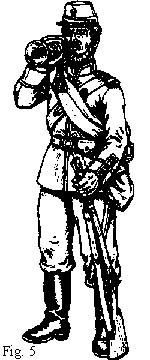 Fig. 5. Cavalry Trumpeter, Campaign, 1866 - 70, Plain dark blue kepi with brass front device (crown above regimental number), white leather chinstrap. Dark blue tunic with dark blue collar and cuffs, red collar patches and cuff flaps, white piping, brass buttons and brass "chain" shoulder straps. Plain dark blue trousers tucked into black boots, white belts, cap pouch an waistbelt and "carbine" sling. Dark blue mantle roll worn over the right shoulder, beige or off-white breadbag on the left hip, brass trumpet with green cords and tassels (note the collar variation with no piping on the rear of the collar).
Fig. 5. Cavalry Trumpeter, Campaign, 1866 - 70, Plain dark blue kepi with brass front device (crown above regimental number), white leather chinstrap. Dark blue tunic with dark blue collar and cuffs, red collar patches and cuff flaps, white piping, brass buttons and brass "chain" shoulder straps. Plain dark blue trousers tucked into black boots, white belts, cap pouch an waistbelt and "carbine" sling. Dark blue mantle roll worn over the right shoulder, beige or off-white breadbag on the left hip, brass trumpet with green cords and tassels (note the collar variation with no piping on the rear of the collar).
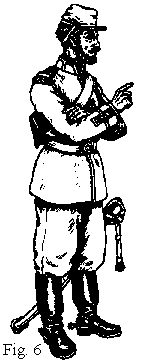 Fig. 6. Cavalryman, Campaign, 1866 - 70, Kepi with white cover, slightly rucked-up at the rear to show the edge of the red band, the white strap worn around the back of the head. Tunic as for the last figure. White trousers, belts and sabre-knot, soft black leather boots in the popular "Gaucho" style, which had a tendency to collapse in folds around the ankle.
Fig. 6. Cavalryman, Campaign, 1866 - 70, Kepi with white cover, slightly rucked-up at the rear to show the edge of the red band, the white strap worn around the back of the head. Tunic as for the last figure. White trousers, belts and sabre-knot, soft black leather boots in the popular "Gaucho" style, which had a tendency to collapse in folds around the ankle.
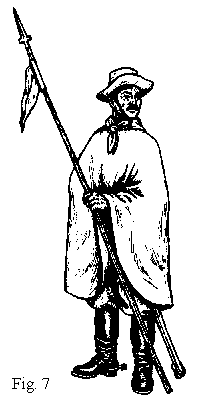 Fig. 7. Cavalryman, Campaign, 1866 - 70, Showing elements of the "Gaucho style" which was particularly popular among mounted troops. Brown felt hat with chincords, dark blue poncho lined red, worn over light brown trousers (probably from the duck working uniform), soft black "Gaucho" boots, red neckerchief. Lance with red over white pennon, the
"sleeve" around the pole being entirely red, lances seem to have been widely used by cavalry, both before and during the war, but their official status is unclear.
Fig. 7. Cavalryman, Campaign, 1866 - 70, Showing elements of the "Gaucho style" which was particularly popular among mounted troops. Brown felt hat with chincords, dark blue poncho lined red, worn over light brown trousers (probably from the duck working uniform), soft black "Gaucho" boots, red neckerchief. Lance with red over white pennon, the
"sleeve" around the pole being entirely red, lances seem to have been widely used by cavalry, both before and during the war, but their official status is unclear.
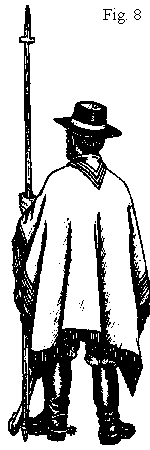 Fig. 8. Cavalry Officer, Campaign, 1866 - 70, Black felt hat with
natural leather band, light brown fringed poncho with horizontal
lines of; dark red - white - dark red showing at the lower sides.
Plain dark blue trousers reinforced with a second layer of the same
material between the legs, black boots, pink neckerchief with double
white edging, lance without pennon. In this guise, this officer is
virtually indistinguishable from his men; many officers making a
deliberate effort to "blend in" on campaign.
Fig. 8. Cavalry Officer, Campaign, 1866 - 70, Black felt hat with
natural leather band, light brown fringed poncho with horizontal
lines of; dark red - white - dark red showing at the lower sides.
Plain dark blue trousers reinforced with a second layer of the same
material between the legs, black boots, pink neckerchief with double
white edging, lance without pennon. In this guise, this officer is
virtually indistinguishable from his men; many officers making a
deliberate effort to "blend in" on campaign.
Fig. 9. Furriel, 1st Cavalry Regt. Full Dress, 1866 - 70, Black shako with brass plate and chinscales, national cockade above the plate, yellow lace top band, red plume. Tunic as described earlier with brass contre-epaulets, 3 red rank stripes edged white on the lower left sleeve. Dark blue trousers with red stripe, white gloves, belts and sabre-knot, black leather sabretache (as depicted in Fig.10). The 1st Cavalry Regiment, which spent the war guarding the Imperial Court in Rio de Janeiro, would be one of the few units to wear the full dress uniform on a fairly regular basis during the war.
Fig. 10. Lieutenant Colonel of Cacadores a Cavallo, Undress / Service Uniform 1866 - 70 Dark blue kepi with yellow band, side and top piping, black chinstrap (there seems to have been considerable variation in kepi trim during this period). Dark blue tunic, including collar, cuffs and cuff flaps, all edged with yellow piping, yellow piping edging the rear pocket flaps, gold buttons and contre-epaulets, two gold rank stripes on the sleeve (one above and one below the yellow cuff piping). Dark blue trousers with yellow piping down the outer seam, crimson waistsash with gold knot and crimson tassels. Black belts with gilt or brass fittings, crowned gilt number "1" on the flap of the sabretache, an unclear gilt: device on the pouch flap, a canteen or water-bottle in a buff or beige cover on a black strap on the left hip, black leather holster and revolver lanyard.
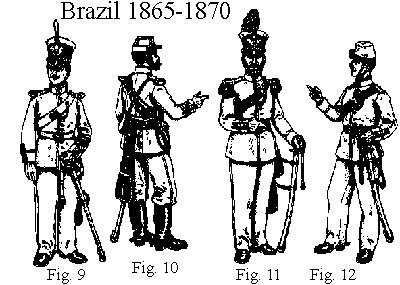 Fig. 11. Captain of Cacadores a Cavallo, Full Dress, 1866 - 70, Black shako with gold fittings and top lace, national cockade, plume of dark green Cock feathers. Dark blue tunic, collar, cuffs and cuff flaps, all yellow piping including the front opening, gold buttons
and epaulets, dark blue trousers with yellow side piping. Crimson and gold waistsash, white gloves, black belts and sabretache, gold full dress sabre-knot. By regulation officers were to continue to distinguish rank by means of epaulets with the full dress uniform, in practice, many simply wore their "Second Tunic" (with cuff lace) with detachable epaulets for full dress.
Fig. 11. Captain of Cacadores a Cavallo, Full Dress, 1866 - 70, Black shako with gold fittings and top lace, national cockade, plume of dark green Cock feathers. Dark blue tunic, collar, cuffs and cuff flaps, all yellow piping including the front opening, gold buttons
and epaulets, dark blue trousers with yellow side piping. Crimson and gold waistsash, white gloves, black belts and sabretache, gold full dress sabre-knot. By regulation officers were to continue to distinguish rank by means of epaulets with the full dress uniform, in practice, many simply wore their "Second Tunic" (with cuff lace) with detachable epaulets for full dress.
Fig. 12. Cacador a Cavallo, Service / Campaign, 1866 - 70, Kepi with white cover, black chinstrap, dark blue tunic, collar, cuffs, cuff flaps and shoulder-straps, all edged with yellow piping, brass buttons, white summer trousers, black belts with brass fittings, black sabre-knot.
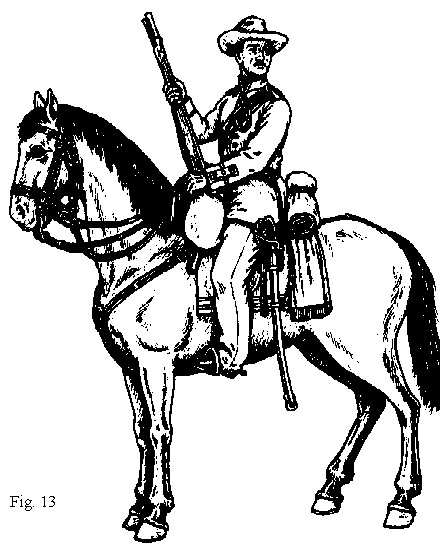 Fig. 13. Cacador a Cavallo, Summer Campaign, 1866 - 70, Brown felt slouch hat, tunic of white duck the collar, front opening, cuffs, cuff flaps and shoulder-straps all edged with yellow piping in the same pattern as the woolen tunic (no rear pocket flaps, however), dark (uncleaned or bronzed?) buttons, plain white duck trousers, black belts and sabre-knot. The saddlecloth is dark blue with a red stripe edged white across the bottom, dark blue holster covers and mantle roll behind the saddle, a brown poncho or blanket hanging down below the mantle. The combination of rifled "Carbine" with cavalry sabre suggests a "general purpose" type corps, able to function as either cavalry or mounted infantry.
Fig. 13. Cacador a Cavallo, Summer Campaign, 1866 - 70, Brown felt slouch hat, tunic of white duck the collar, front opening, cuffs, cuff flaps and shoulder-straps all edged with yellow piping in the same pattern as the woolen tunic (no rear pocket flaps, however), dark (uncleaned or bronzed?) buttons, plain white duck trousers, black belts and sabre-knot. The saddlecloth is dark blue with a red stripe edged white across the bottom, dark blue holster covers and mantle roll behind the saddle, a brown poncho or blanket hanging down below the mantle. The combination of rifled "Carbine" with cavalry sabre suggests a "general purpose" type corps, able to function as either cavalry or mounted infantry.
Other Installments:
-
Imperial Brazilian Uniforms (Part 1): Line Infantry
Imperial Brazilian Uniforms (Part 3): Artillery
Imperial Brazilian Uniforms (Part 4): General Staff and Engineers
Imperial Brazilian Uniforms (Part 5): "Fixed" or Garrison Corps
Imperial Brazilian Uniforms (Part 6): Guardia Nacional
Back to Table of Contents -- El Dorado Vol VII No. 3
Back to El Dorado List of Issues
Back to MagWeb Master Magazine List
Copyright 1996 by The South and Central Military Historians Society
This article appears in MagWeb (Magazine Web) on the Internet World Wide Web.
Other military history articles and gaming articles are available at http://www.magweb.com